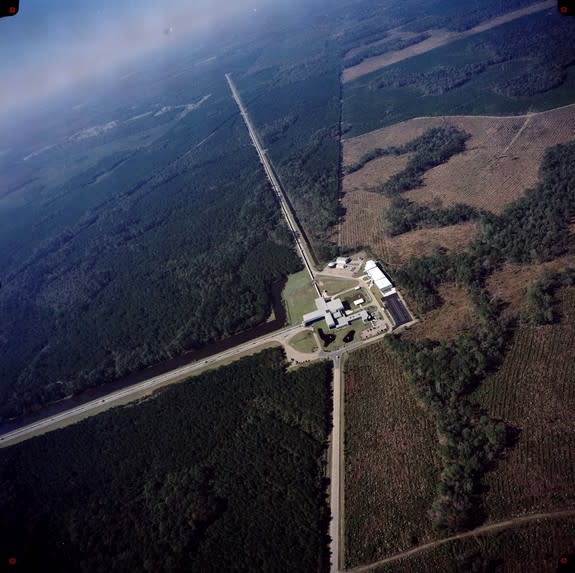Project LIGO: How Lasers Could Reveal Glimpses of Gravitational Waves
The ripples from violent cosmic collisions can be felt far across the universe, and thanks to a new, sensitive detector expected to start collecting data next year, scientists might be able to see evidence of those gravitational waves from Earth for the first time.
When two neutron stars (remnants of supernova explosions) merge or when a black hole merges with a neutron star, the reverberations of the merger can extend throughout the cosmos. Light, however, only tells us so much. To learn more about the mass and motion of the collision, astronomers want to use gravitational waves, ripples in space-time created during these massive crashes.
Next year, astrophysicists are set to switch on one of the most sensitive gravitational-wave detectors ever created. The observatory is called the Laser Interferometer Gravitational-Wave Observatory (LIGO, for short). It originally had six observing runs between 2004 and 2010, and has been offline for half a decade to make upgrades. The return, its backers say, will be worth it. [Photos: Hunting Gravitational Waves with LIGO]
"It opens us up to [viewing] a larger number of astrophysical events," said David Reitze, the LIGO Laboratory's principal investigator and director. One improvement will be better sensitivity in lower frequencies, which will let astronomers look for black holes of between 100 and 500 times the mass of the sun if they exist.
A new documentary about LIGO, titled "LIGO, A Passion for Understanding," is set to premiere on Space.com April 15. You can watch it on Space.com or directly from the filmmaker Kai Staats here: http://www.kaistaats.com/film/ligo/.
From the Big Bang to big star explosions
Gravitational waves hit the headlines in March when the scientific instrument BICEP2 (short for Background Imaging of Cosmic Extragalactic Polarization) found the first direct evidence of cosmic inflation, or the huge expansion of the cosmos that happened shortly after the Big Bang.
LIGO, however, searches for waves at higher frequencies, in the 10 hertz to 10 kilohertz band. The primordial waves discovered by BICEP2, Reitze said, are 20 orders of magnitude lower in frequency.
While LIGO was not really designed to look for primordial waves, scientists did search for them. Researchers described what was then the most accurate upper limit on the primary gravitational- wave background in high frequencies. The results were published in a 2009 issue of the journal Nature in 2009 (and have since been superseded by BICEP2, Reitze said.)
Another prominent result came when scientists measured how round pulsars — super-dense, tiny, spinning remnants of supernovas — are by tracking asymmetries on their surfaces. "If it has a bump and the bump is big enough, it will generate a gravitational wave," Reitze said.
Measurements of the Crab Nebula's pulsar by LIGO yielded no "mountains" higher than one meter (3.4 feet). "Certain pulsars, are even better, with less than a millimeter high," Reitze added.
Stopping for trains and earthquakes
LIGO originally consisted of two interferometers (telescope receivers that work together) at Hanford (near Richland, Wash.) and one in Livingston, La. The $205 million advanced LIGO has one interferometer in each location, with the third one going somewhere off continent — likely India. The government there is calling this project "one of the hallmark science detectors," Reitze said, and site evaluation is underway.
Wherever the interferometer goes, it has to be a region that is not too prone to earthquakes, lest the sensor get mixed up. Despite advanced stabilization technology, shaking does happen. "And we monitor the shaking to make sure it doesn't corrupt the data," Reitze said. [Watch the trailer for "LIGO, A Passion for Understanding"]
There's a procedure at Hanford and Livingston to stop science work when earthquakes occur. Observations at Livingston also must stop temporarily if a 50-car cargo train rumbles by on a track about 1.5 miles (2.4 kilometers) away.
"There are automatic protocols (using sensors and software) which monitor earthquakes and take the interferometers out of 'science mode' during seismic disturbances from earthquakes," Reitze said.
Each interferometer works by injecting a laser into a vacuum system, which splits the beam in half to put the resulting beams at right angles to each other. Each beam goes to mirrors about 2.5 miles (4 kilometers) away, which reflect back.
The gravitational waves cause tiny but measurable distortions in the laser beams that cause a "changing interference pattern" in the photosensors that read the laser reflections, Reitze said. "In comparative scale, if you take the nucleus of an atom and take its diameter and divide that by 10,000, that's the type of a distance change we're looking at."
LIGO's capabilities will be 10 times more sensitive than before in searching for binary neutron star mergers, and it will be better able to pick up on many other cosmic phenomena as well – such as black holes and supernovas. The principal funder was the National Science Foundation, and the California Institute of Technology leads laboratory operations.
Follow Elizabeth Howell @howellspace. Follow us @Spacedotcom, Facebook and Google+. Original article on Space.com.
Copyright 2014 SPACE.com, a TechMediaNetwork company. All rights reserved. This material may not be published, broadcast, rewritten or redistributed.


